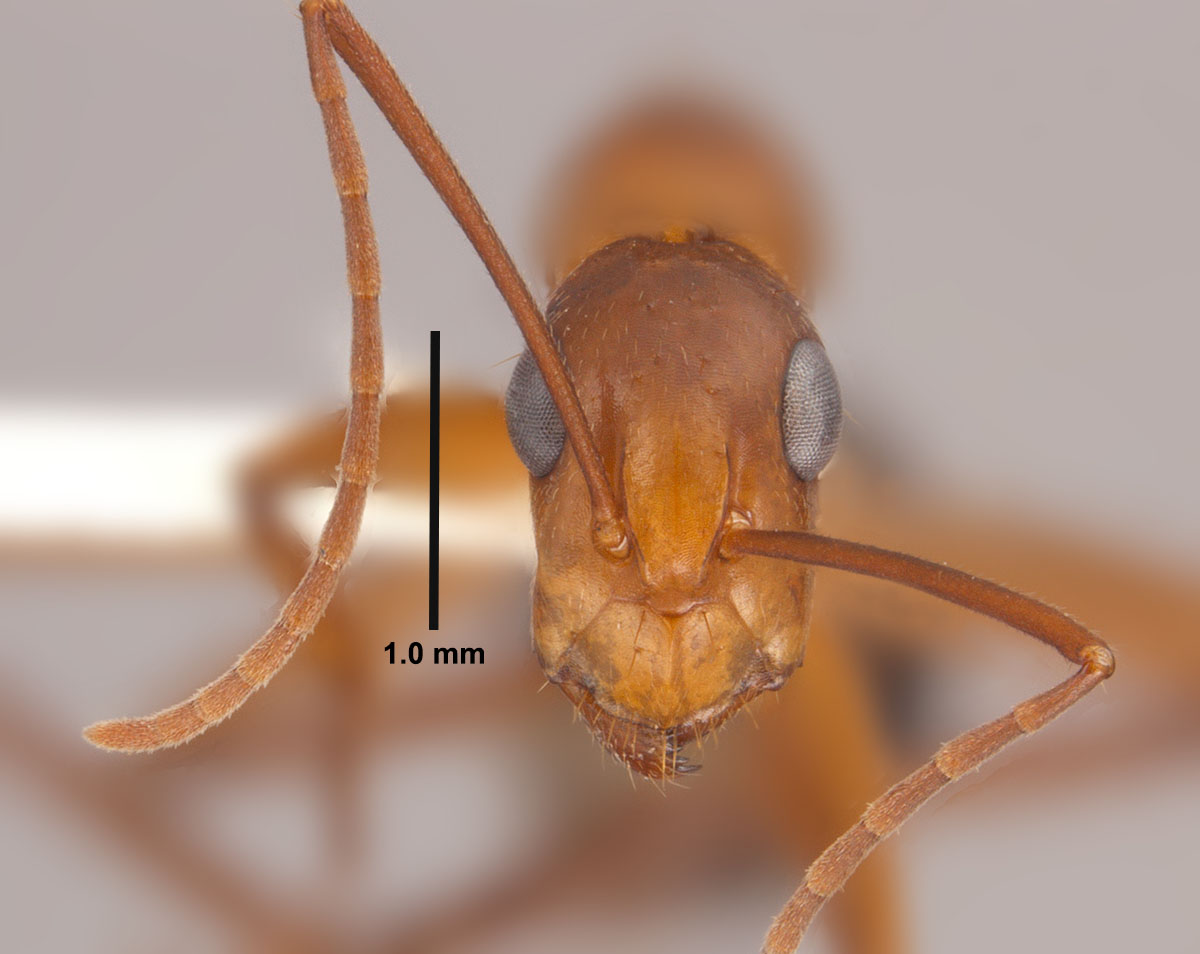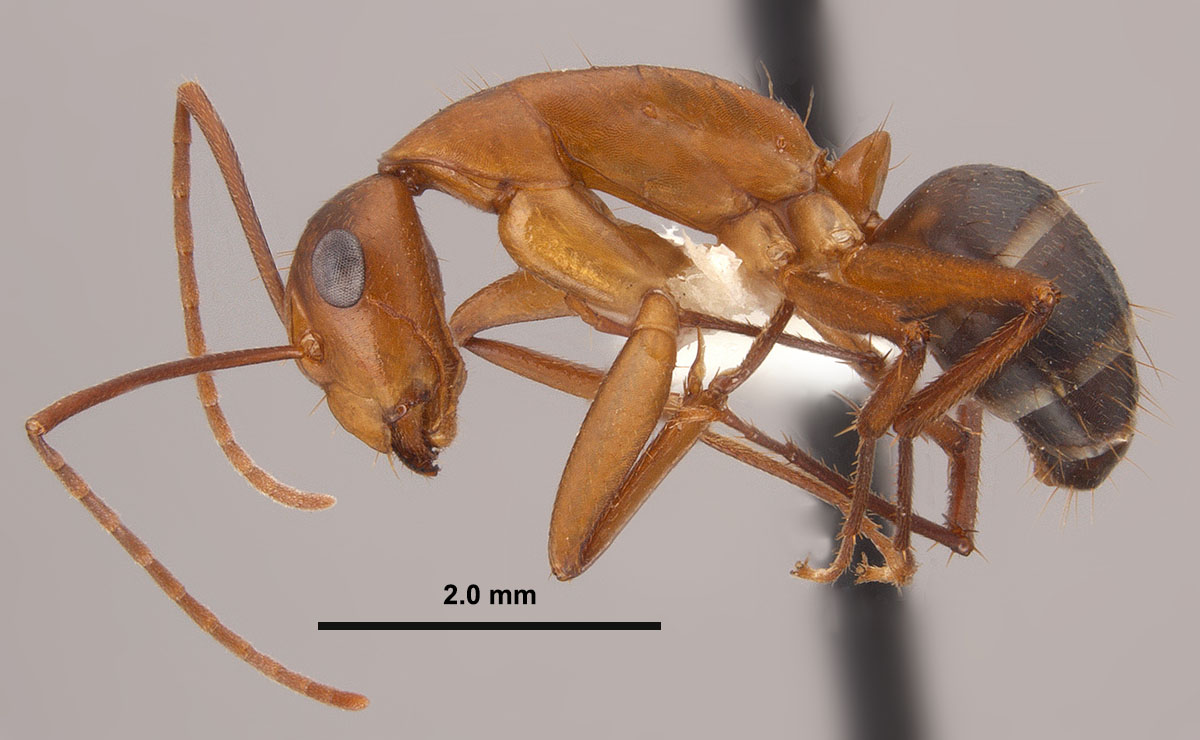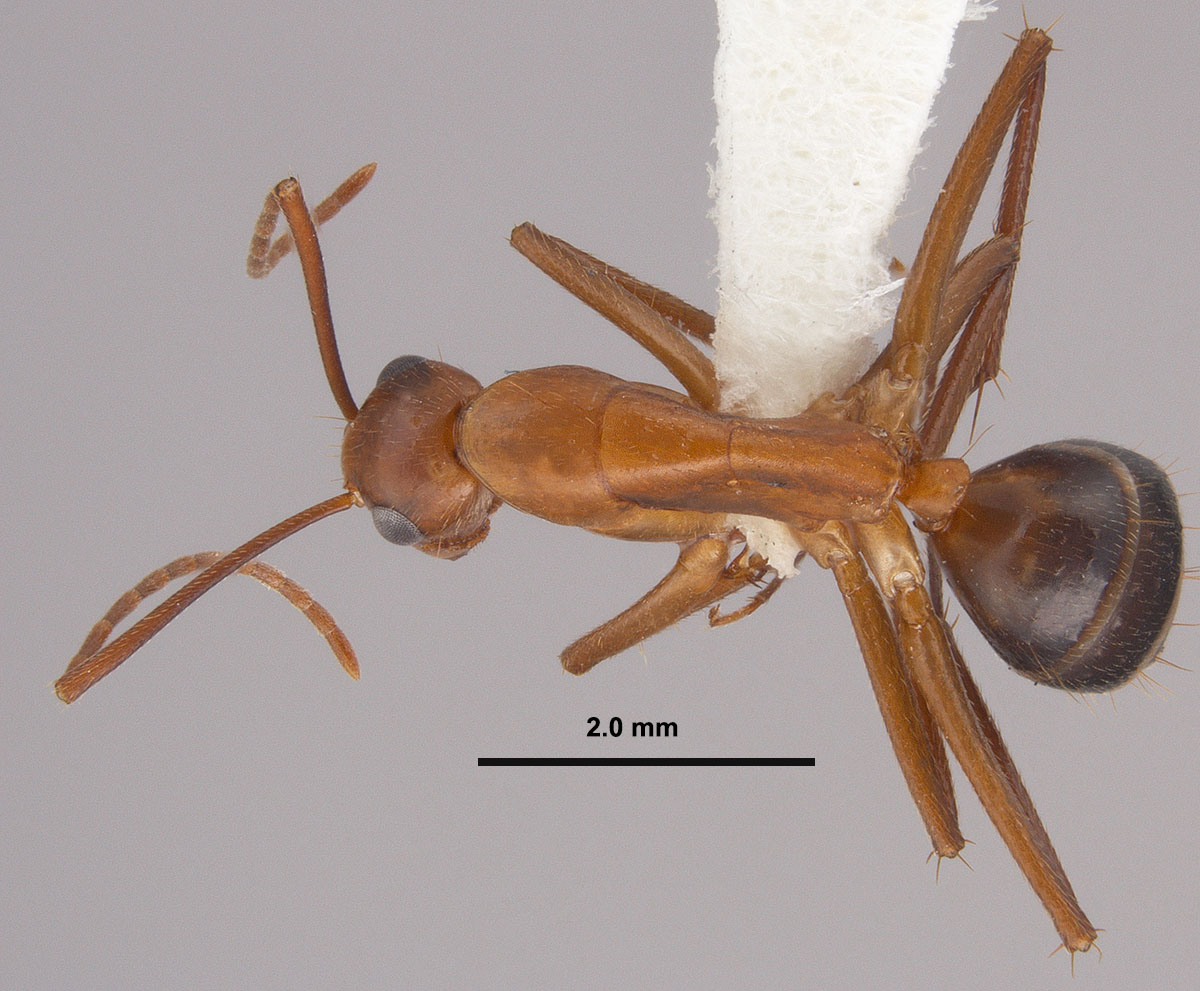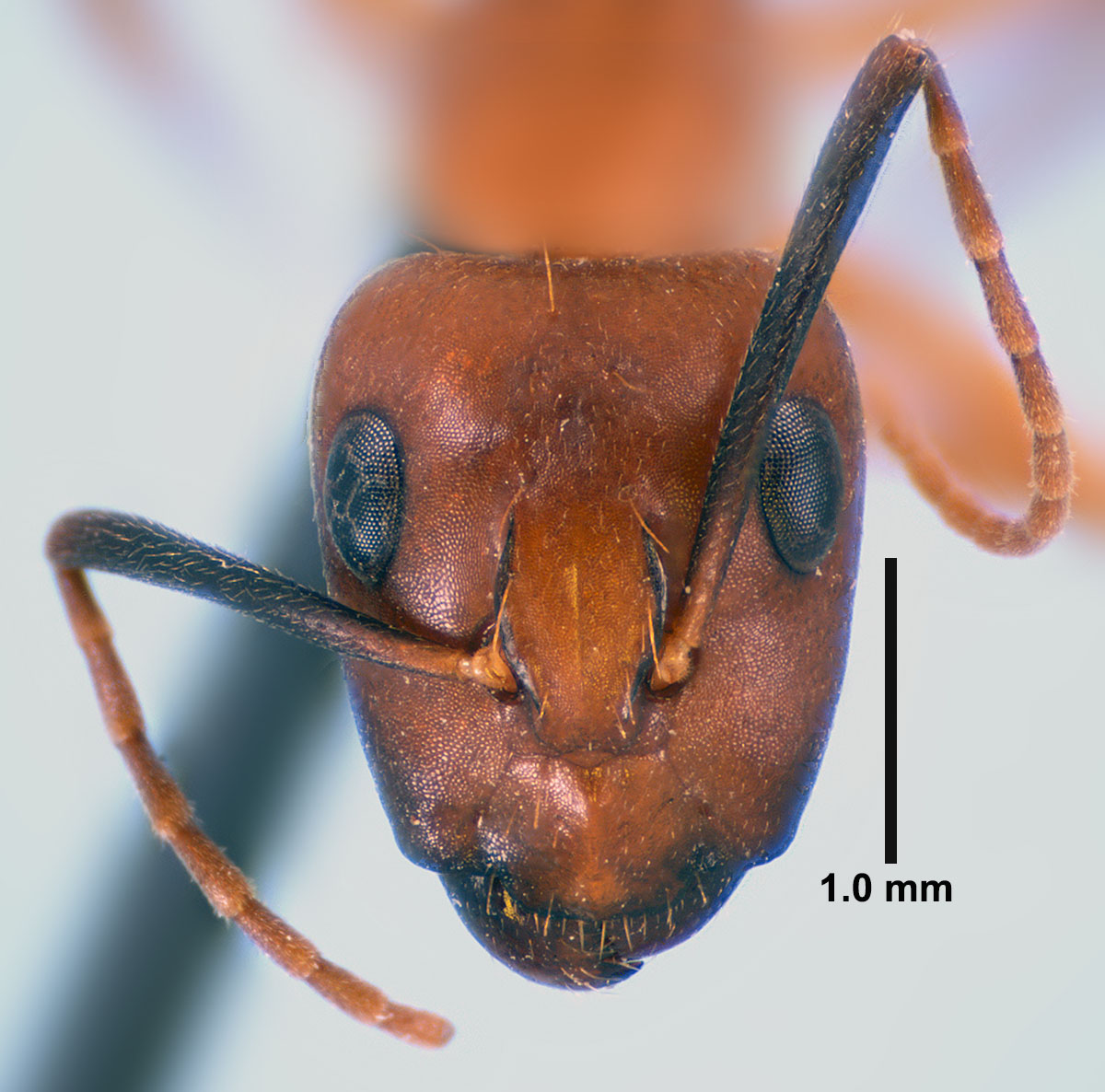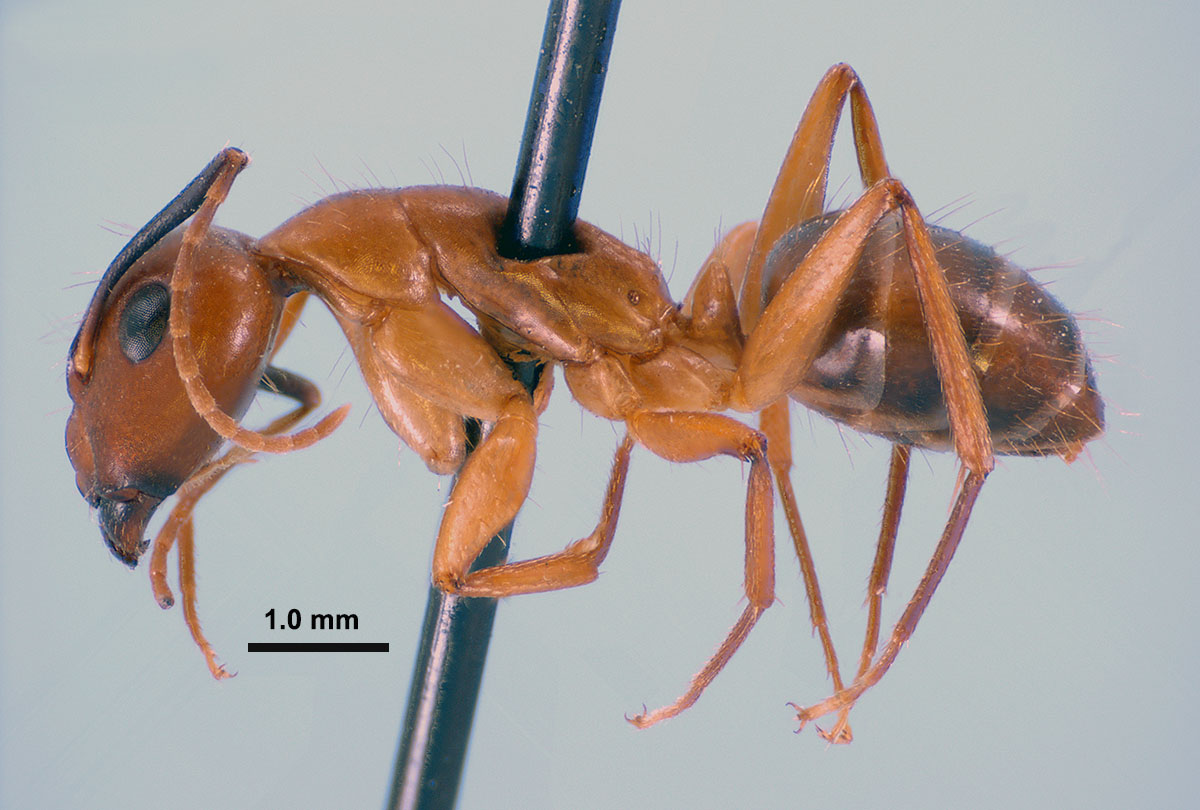Subfamily FORMICINAE Tortugas carpenter ant Author: Joe A. MacGown |
||
Camponotus tortuganus, full face view of the head of a worker (MS, Hancock Co.) (photo by Joe A. MacGown) |
Camponotus tortuganus, side view of the head of a worker (MS, Hancock Co.) (photo by Joe A. MacGown) |
Camponotus tortuganus, top view of the head of a worker (MS, Hancock Co.) (photo by Joe A. MacGown) |
Camponotus tortuganus, full face view of the head of a worker (FL, Brevard Co.) (photo by Joe A. MacGown) |
Camponotus tortuganus, top view of the head of a worker (FL, Brevard Co.) (photo by Joe A. MacGown) |
|
Introduction Species in this genus are variable in size with workers ranging in size from 3.0 to 15 mm or more in length and queens (also referred to as females) of some species attaining a length of 19 mm or more. Many species are polymorphic. Workers have a 12-segmented antenna that lacks an apical club. Antennal fossae do not touch the posterior border of the clypeus. Ocelli are not present on the heads of workers. The workers of most species have an indistinct metanotal suture between the promesonotum and the propodeum, although this suture is present in C. sexguttatus and some members of the related genus Colobopsis. Those species that lack the obvious and deep metanotal suture have the shape of the alitrunk in a smoothly curved arc (as seen in profile). Camponotus tortuganus is in the subgenus Tanaemyrmex, which differs from the other carpenter ant subgenera by having a median carina present on the clypeus. The status of this species is unclear. Historically, specimens of this species from the US have been identified as C. tortuganus, but after closer examination by Mark Deyrup (per. com. Mark Deyrup, Archbold Biological Station), he noted that some specimens in southern Florida could be C. c. inaequalis. The status of this species is unclear. In 1863, Roger described C. inaequalis from Cuba. Later, in 1895, Emery described C. maculatus tortuganus from a specimen collected by Pergande in the Dry Tortugas. Forel (1914) sunk C. inaequalis to a subspecies of C. conspicuuus. Wheeler (1923) raised C. tortuganus to species. From that point onward until 1988 (Deyrup et al. 1988), specimens collected in Florida were called C. tortuganus. However, Deyrup et al. (1988) discovered specimens in the Florida Keys whose striped coloration matched C. c. inaequalis. Specimens resembling typical C. tortuganus were also collected in the Keys. According to Deyrup (Pers. Comm.), numerous specimens with C. c. inaequalis and C. tortuganus-inaequalis coloration have been collected in Florida since approximately 1965. Wetterer and O'Hara (2002) stated that the holotype collected by Pergande was actually labeled as being from the Bahamas, rather than from the Dry Tortugas. Further, in the Wetterer and O'Hara (2002) publication, they stated that specimens identified from Florida as C. tortuganus were actually C. conspicuus zonatus Emery, 1894. This seems unlikely, as C. c. zonatus has a Central American distribution. Future genetic work could be useful in more definitive identifications of this group in the USA. Based on Deyrup's collections (Pers. Comm.), its seems likely that both C. tortuganus and C. c. inaequalis may be present in Florida and that these two species may be interbreeding forming a hybrid. Alternatively, C. tortuganus and C. c. inaequalis could actually represent variations of the same species, in which case the name C. c. inaequalis would have priority. Specimens of the color form matching C. tortuganus also have been collected from coastal Mississippi. Currently, I am using the name name C. tortuganus here for the color forms from Mississippi and for specimens I have examined from Florida. Taxonomic History (Bolton 2016) Diagnosis Identification Minor Worker: Large: TL ≈ 6.5-8.0mm, HL 01.66–1.80mm, HW 1.18–1.22mm, SL 2.20mm, EL 0.5mm, MeSL 2.80–2.90mm (n= 5) (MEM specimens). Bicolored: head, mesosoma, waist, legs, and antennae orangish brown and gaster dark reddish brown to brownish black (sometimes with lighter striped areas at posterior edges of gastral tergites). Head much longer then wide, giving it a narrowed appearance; shiny, mostly lacking sculpture, with scattered short, appressed pubescence; head with several stiff, erect stiff present at posterior corners; cheeks lacking erect setae; clypeal face with several erect setae; antennal scapes lacking erect setae; eyes large, anterior edge of eye beginning at approximately the halfway point of head; scape longer than head length; clypeus with a sharp and well defined median carina present, anterior clypeal margin entire. Mesosoma smoothly arched in lateral view, with fine microsculpture, but mostly shiny; sparse pubescence; several long, semi erect, curved setae present dorsally. Waist with a single erect petiolar node; node wider at base than apex, convex anteriorly and relatively straight on posterior side; shiny with long erect setae apically. Gaster shiny, with sparse, appressed pubescence and numerous elongate, semi erect, curved setae; acidopore present. Queen: (From description of C. tortuganus provided by Wheeler, 1910) – Large: TL ≈ 10.0–11.0mm; FWL 11.0mm. Resembling the worker major in sculpture, pilosity and color. Head proportionately longer. Eyes large and convex. Mesosoma as broad as the head, rather depressed; propodeum with indistinct base and declivity, the former fully as long as the latter. Petiole similar to that of the worker major. Forewing with amber coloration, especially along top third of wing; veins and stigma pale brownish yellow; costal, submarginal, marginal, basal, and subbasal cells closed; discal cell absent. Males: (From description of C. tortuganus provided by Wheeler, 1910) - Total Length approximately 7.0 mm. Head through the eyes about as wide as long. Eyes and ocelli very large. Cheeks much shorter than the eyes, straight and parallel. Posterior portion of head broad and rounded. Clypeus subcarinate, with broadly rounded, projecting anterior border. Mandibles narrow, edentate. Antennae slender, first funicular joint as long as the second, distinctly incrassated. Mesosoma robust, with low, evenly rounded propodeum; its base and declivity indistinctly differentiated, the former about twice as long as the latter. Petiole longer than high, with a low, thick, transverse node. Gaster and legs slender. Biology and Economic Importance Workers from Mississippi were collected as they foraged along outdoor irrigation hoses at an outdoor palm nursery. This particular nursery was known for importing palms from southern Florida, and we suspect that the ants were stowaways in a plant shipment. In Florida, this species occurs on beaches, in scrub habitat, and in disturbed areas. Nests are typically found under objects, in structures. Pest Status Distribution Nearctic: United States (AntWiki.org and MEM). U.S. Distribution: FL, MS (AntWeb.org and MEM). Acknowledgments Bolton, B. 2016. Bolton World Catalog Ants. Available online: http://www.antweb.org/world.jsp. Accessed 7 November 2016. Bolton, B. 2016. Bolton World Catalog Ants. Available online: http://www.antweb.org/world.jsp. Accessed 9 March 2016. Creighton, W. S. 1950. The ants of North America. Bulletin of the Museum of Comparative Zoology 104:1-585. Deyrup, M. 2003. An updated list of Florida ants (Hymenoptera: Formicidae). Florida Entomologist 86: 43-48. Deyrup, M., N. Carlin, J. Trager, and G. Umphrey. 1988. A review of the ants of the Florida Keys. Florida Entomologist 71: 163-176. Deyrup, M., L. Davis, and S. Cover. 2000. Exotic ants in Florida. Transactions of the American Entomological Society 126: 293-325. Emery, C. 1895. Beiträge zur Kenntniss der nordamerikanischen Ameisenfauna. (Schluss). Zoologische Jahrbücher. Abteilung für Systematik, Geographie und Biologie der Tiere 8:257-360. Emery, C. 1895. Beiträge zur Kenntniss der nordamerikanischen Ameisenfauna. (Schluss). Zoologische Jahrbücher. Abteilung für Systematik, Geographie und Biologie der Tiere 8:257-360. Emery, C. 1920. Le genre Camponotus Mayr. Nouvel essai de la subdivision en sous-genres. Revue Zoologique Africaine (Brussels) 8:229-260. Emery, C. 1925. Hymenoptera. Fam. Formicidae. Subfam. Formicinae. Genera Insectorum 183:1-302. Forel, A. 1914. Le genre Camponotus Mayr et les genres voisins. Revue Suisse de Zoologie 22:257-276. Hansen, L. D., and J. H. Klotz. 2005. Carpenter ants of the United States and Canada. Cornell University Press. Ithaca, N. Y. i-xii+204 pp. Roger, J. 1863. Die neu aufgeführten Gattungen und Arten meines Formiciden-Verzeichnisses nebst Ergänzung einiger früher gegebenen Beschreibungen. Berliner Entomologische Zeitschrift 7:131-214. Smith, D. R. 1979. In Catalog of Hymenoptera in America north of Mexico. Smithsonian Institution Press, Washington D. C. Vol. 2, pp. 1323-1427. Wetterer J. K. and O’Hara B. C. 2002. Ants (Hymenoptera: Formicidae) of the Dry Tortugas, the outermost Florida keys. Fla. Entomol. 85: 303–307. Wheeler, W. M. 1910. The North American ants of the genus Camponotus Mayr. Ann. N. Y. Acad. Sci. 20: 295-354. Wheeler, W. M. 1913. The ants of Cuba. Bulletin of the Museum of Comparative Zoology 54:477-505. Wheeler, W. M. 1932. A list of the ants of Florida with descriptions of new forms. Journal of the New York Entomological Society 40:1-17. Wilson, E. O. 1964. The ants of the Florida Keys. Breviora 210:1-14. Links |
||


